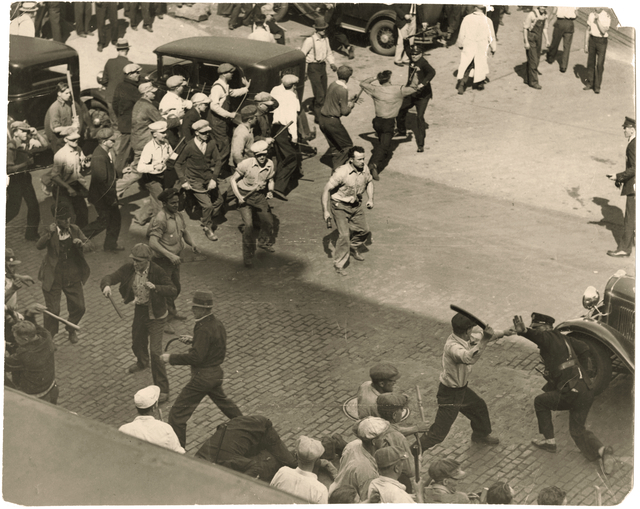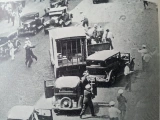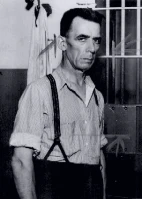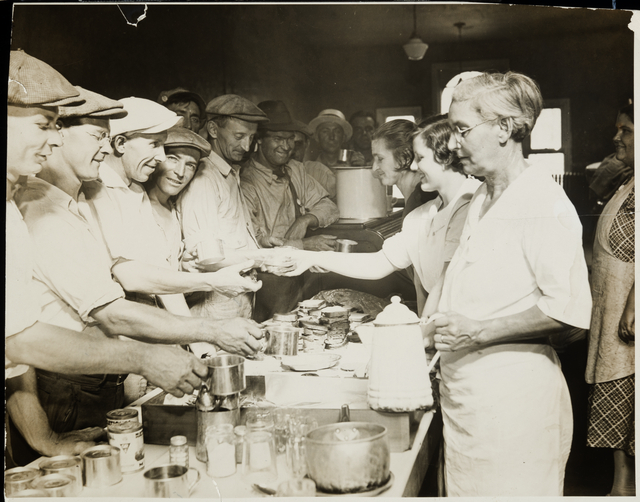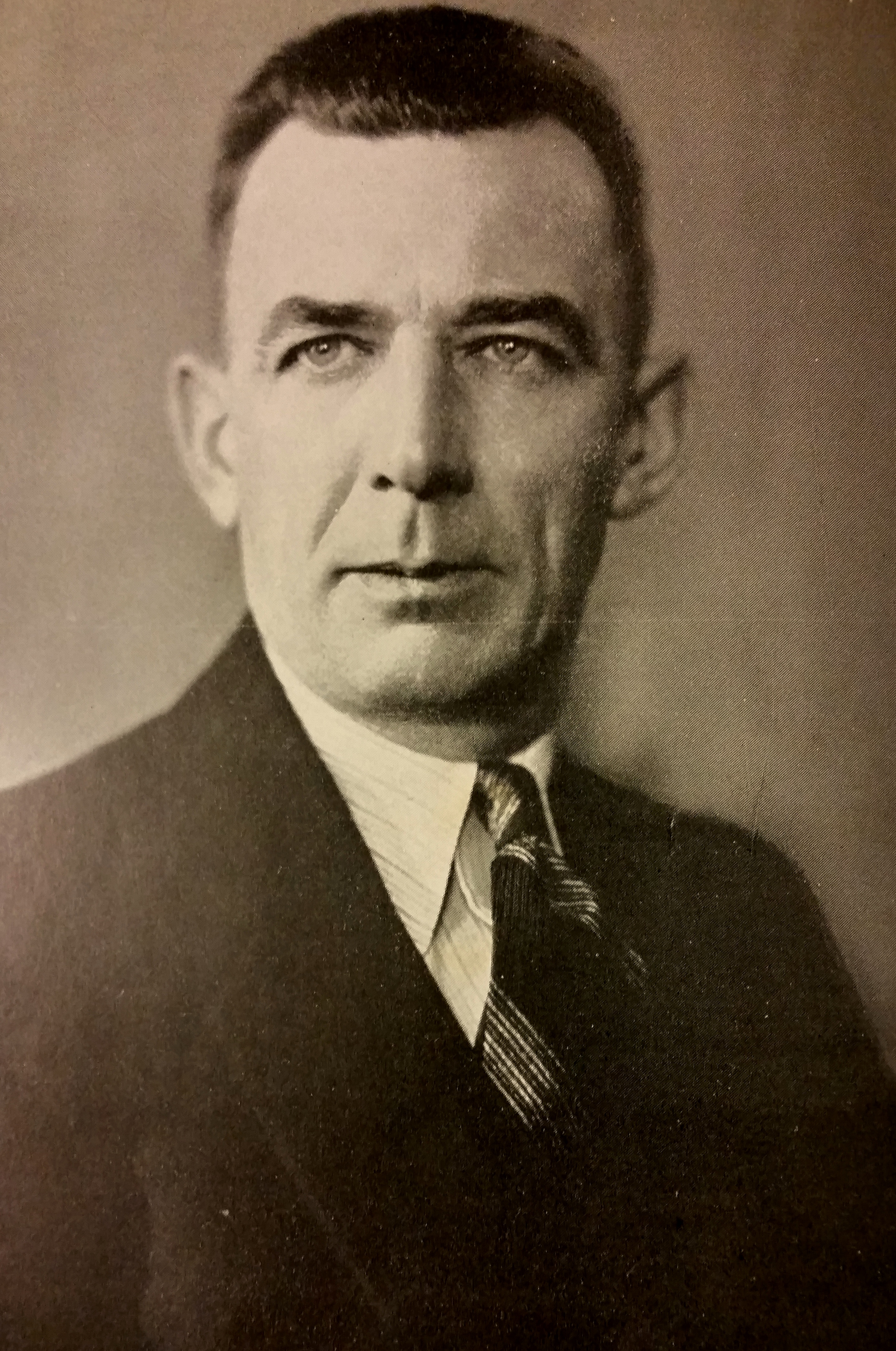Fight for 52¢ reviews
Kings River Life Magazine – Fresno
Fight For 52 Cents
Review by Mallory Moad March 8, 2020
In his living history production, Fight For 52 Cents, Howard Petrick portrays union organizer Vincent Raymond Dunne. I chose to see this show because my knowledge of all things union is sadly lacking and while I expected to be educated, I was pleasantly surprised at how entertained I was.
The story takes place in 1969 at a ceremony commemorating the thirty-fifth anniversary of the 1934 Truck Drivers’ Strike in Minneapolis, a pivotal moment for the labor movement. Dunne is the featured speaker, the audience members the attendees of the event.
With gray hair and a sharp pin-striped suit, Petrick plays the 80-year-old Dunne not so much as an old man, but as a man who has seen, experienced and achieved much in his lifetime. In an easy-going style, he recounts stories of Dunne’s life, from his childhood living on the prairie in Minnesota to his first encounter with the Industrial Workers of the World and finally, his role in the Truck Drivers’ Strike.
Although the show is augmented with recorded sound effects and music, it is Petrick’s performance that really drives it. A skilled storyteller, he easily slips into a variety of characters using only his voice and posture. His vivid descriptions and dry sense of humor transform what could have been just a recounting of history into a suspenseful, exciting saga.
While The Fight For 52 Cents is based on events that occurred in the past, it contains messages that are pertinent to the present. “You don’t stick a label on people then write them off because they don’t agree with you,” Dunne tells us. Solidarity, greedy capitalists vs. working people and the creativity of the working class are recurrent themes.
I highly recommend Fight For 52 Cents, especially if you’re looking for a Rogue experience that is more gentle than chaotic. It’s definitely educational, but more than that, it’s enjoyable and inspirational. Power to the people? Right on!
Ian C Nelson, Bilingual director, dramaturge and actor
Potash Fringe Festival, Saskatoon,SK
Victoria Upstairs This play may be the most undervalued offering in this year’s Fringe I’m afraid. Surrounded by shows with a definite Fringe “edge” and some very lively physical theatre and music offerings, first of all the subject might appear to be aimed at a niche public. Added to this, the performance I attended was on a dismal, rainy night when only a shamefully small audience trekked up the three flights of stairs to the Victoria School Auditorium to attend. I can only lament how unfair this is, for this presentation by Howard Petrick is the gold standard in storytelling. He recreates an evening when V.R.Dunne at the age of 80 has been asked to speak at a meeting to mark the 35th anniversary of the Minneapolis truck drivers’ strike of 1934. We, the audience, are Ray Dunne’s assembled union folk for the 60-minute duration. This illusion is maintained to perfection. How does a patriarch of the union movement hold his public spellbound? With the simple, low-key retelling of how all it all came about. At one point he assumes the voice of a negro prisoner, but it is still the old man who is adding this little touch to his personal saga. He tells of meeting a blonde Swedish waitress with a sharp tongue and you know by the new warmth in his demeanor that this is significant. A little later you catch why because in recounting another turn of events, he just throws in a few extra words on the side. Petrick’s personal acquaintance with the subject no doubt informed the whole presentation. His acting choices are brilliant: the voice, the little hesitations in speech, the restrained gestures, the unerring sense of his physical space, when stillness is called for and when a little movement will seal the moment.
After the performance the actor/writer invited comments about the evening, as he said he is still working on this piece. Frankly , it felt finished and highly polished to me. The story is replete with details of the time, the people and the strategies that pushed formation of unions, yet it is done with such craft and limpid coherence that there is no effort in following the history.
Treat yourself to an utterly entrancing experience and show your appreciation for a master storyteller.
Elgin Walkabout Review
“Fight for 52 cents”
At Elgin Public House
When the past becomes the present is makes sense to listen. Howard Petrick shares an intimate story about union organizer and social leader V.R. Dunne back during a time when joining a union sometimes meant enduring physical violence or even the loss of your life. Petrick tells this story simply almost like a family member conjuring up memories from a much different time in American life. He addresses his audience directly without frills allowing truth to power. What surprises you as the story is told is how some things seem to never change in our society and how we must all fight for what is right no matter the cost.
____________________________________________________________________________________________
Fight for 52¢ in U.S. Labor History
by Kathy Slaughter | Aug 21, 2017 | IndyFringe17, Reviews
Fight for 52¢ might not make much sense in today’s economy. There’s not much you can buy for 52 cents. Back in 1934 however, it was a different story. This one-man show, produced and performed by Howard Petrick of San Francisco, tells the story of V. R. Dunne, labor organizer. With the backdrop of today’s political divisions, Dunne’s story is quite timely.
The set is simple – a chair with a side table. As Mr. Dunne is announced, the audience learns they are members of the Teamsters Union, gathered together in the mid-1960s to hear a respected union rep speak. Mr. Dunne enters and seats himself, explaining he hasn’t spoken in front of a crowd for quite some time. The truth is, Mr. Dunne is an excellent storyteller. This show tells the story of one the most important strikes in American Labor History. In 1934, worker’s unions were struggling to be effective. Thanks to the Depression, jobs were scarce and scabs easy to hire. Three successful strikes that year began the rise of industrial unionism and labor reforms.
Since Mr. Dunne is a great storyteller, he starts at the beginning. He was born in Kansas City in 1889. His father worked for the railroad until his legs broke in an accident. The family relocated to Minnesota, near his mother’s family. Many hardships led to young Mister Dunne leaving home to work in the lumber industry at the tender age of 14. He worked as a lumberjack and farmhand from 4 am until dark until he moved to Montana in 1905. At the Montana lumber camp, he meets a representative from Industrial Workers of the World. Dunne describes with wonder how much better his working conditions were. The bunkhouses were clean and furnished with linen, work days didn’t last from dawn until dark, and he had Sunday off every week. Dunne realizes that solidarity can overcome greed and it is possible for workers to improve their lives.
The show describes the working conditions of nearly a hundred years ago. Fight for 52¢ includes details about the successful Teamsters strike in Minneapolis, Minnesota in 1934. He talks about the violence striking workers faced at the hands of police. He describes how the use of a Women’s Auxiliary enabled the striking workers to succeed. He discusses the importance of music and fellowship to successful organizing. He explains why he is a communist. To hear the rest of the story, better go buy a ticket right now.
NUVO Indy’s alternative voice
NUVO Indy’s alternative voice
IndyFringe 2017: Fight for 52 Cents
Mark A. Lee Aug 21, 2017, Updated Aug 23, 2017
Four Stars
Howard Patrick from San Francisco embodies the part of V.R. Dunne in a drama that is sprinkled with humor and irony throughout. Fight for 52 Cents gives a first person account of Dunne as he becomes a member of the union, and eventually leads the fight for workers to get a substantial increase in their wages, all while being a member of the Communist Party. Much of the humor is derived from the way things were back then to how they are now. For example, at one point he talks about how all kinds of people are referring to our President and Vice President as fascists. After a brief pause he goes on to say, “You know, I don’t like Richard Nixon and Spiro Agnew anymore than you do. …” It’s a compelling piece that’s very well done and has a lot to say about our current situation while talking mostly about the ‘30s and ‘60s. I’m giving it four out of five stars. I think if he succeeded in petitioning the theater to get their air conditioning fixed I would be willing to go a half a star higher.
Jay Harvey Upstage – Indianapolis
Another show with a social-justice edge is “The Fight for 52 Cents.” Speaking in the person of heroic Minneapolis labor leader V.R. Dunne, Howard Petrick recalls the bloody 1934 truckers’ strike in that city, imaginatively set 25 years later and recalled with steady pride and just a trace of bitterness.
Petrick holds the attention on Theatre on the Square’s intimate Stage II in a monologue that takes class warfare seriously. An entrenched ruling class made the eventual labor victory quite hard-won. Petrick’s folksy yet steely demeanor in the role of Dunne is bound to have you rooting for his cause, no matter your politics (I hazard a guess!). We may rightly think we live in polarized times now, but there is precedent for them in such struggles as the one Petrick brings to greater awareness through this show.
City Beat (Cincinnati)
Review: ‘Fight for 52¢’
BART BISHOP
JUNE 1, 2017
Although history repeats itself, playwright and actor Howard Petrick hopes that Americans in 2017 can learn from the past and change their future.
“Time is a flat circle.” So says Rust Cohle in the first season of HBO’s True Detective. With that philosophy of pessimism comes the idea that history repeats itself. But playwright and actor Howard Petrick hopes that Americans in 2017 can learn from the past and change their future.
Petrick, in reality, met Vincent Raymond Dunne in 1965 and heard his story of leading the union truck drivers’ strike in Minneapolis in 1934. Dunne was a good man and loyal leader, modest and quiet, but when it came to his men and his beliefs, he was a firecracker. This one-man performance is based in themes of social justice that is clearly in the PG-13 range, but it could also be important for young people to witness: Petrick tells how, 80 years later, things really aren’t that different for blue-collar workers in America.
At the Coffee Emporium, Petrick (whose previous shows dealing with the struggles of the working class include Breaking Rank! and Never Own Anything You Have to Paint or Feed) sits in the center of the stage in a suit and tie, his gray hair slicked back, sipping a tumbler. It’s 1969 and the recent progress in the Civil Rights and the anti-Vietnam War movements have spurred Dunne to tell his tale from 35 years earlier. His revolutionary fervor hasn’t subsided, as he paces the creaking stage, even if his politics aren’t for everyone.
Dunne was a Marxist, the founder and leader of the American Communist Party. What’s amazing is how Petrick builds empathy with the audience. He portrays Dunne with a staunch dignity and world-weary wisdom reminiscent of the actor Sam Elliott, but he’s also incredibly affable. He lures you in with vignettes from Dunne’s early days, including his rough childhood, riding the rails to find work and meeting and falling in love with his wife. It’s a portrait of a man that could be anyone’s grandpa. Petrick himself draws the listener in, creating a vivid picture of early 20th-century life, with voices for Dunne’s encounters with African-American prisoners, Swedish activists and his own wife that are believable but understated.
What’s most important is how Dunne’s words resonate today. Although Petrick’s story, without music or other accompaniment, is engaging, it does tend to ramble and diverge in odd directions. But those directions always revolve around key themes in the 21st century — the importance of words and how they can be used against others, and how an oppressed people can’t let themselves be pushed around by the authorities.
Calling the enemy a fascist, for instance, is just as wrongheaded as all communists being painted as evil. And all-out war with the police in the streets of America might seem like a dim memory. But it’s strangely topical.

The Battle of Deputies Run. Minneapolis truck drivers’ strikes 1934.

